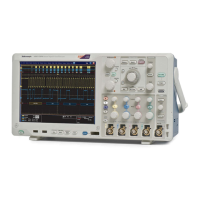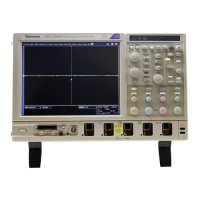Commands Listed in Alphabetical Order
PCTCROss measu
res the location of the eye crossing point expressed as a
percentage of EYEHeight.
Crossing percent = 100 ×[(eye-crossing-point - PBASe)/(PTOP - PBASe)]
PDUty (positive duty cycle) is the ratio of the positive pulse width to the signal
period, expressed as a percentage. It is measured on the first cycle in the
waveform or gated region.
Positive Duty Cycle = (Positive Width)/Period × 100%
PEAKHits measures the number of points in the largest bin of the histogram.
PERIod is the time required to complete the first cycle in a waveform or gated
region. Period is the recipr oc al of frequency and is measured in seconds.
PHAse measures the phase difference (amount of time a waveform leads or lags
the reference waveform) between two waveforms. The measurement is made
between the middle reference points of the two waveforms and is expressed in
degrees, where 360° represents one waveform cycle.
PK2Pk (peak-to-peak) finds the absolute difference between the maximum and
minimum amplitude in the entire waveform or gated region. When histogram is
selected with the MEASUrement:METHod command, the PK2Pk measurement
measures the histogram peak to peak difference.
PKPKJitter measures the variance (minimum and maximum values) in the
time locations of the cross point.
PKPKNoise measures the peak-to-peak noise on a waveform at the mid reference
level.
POVershoot
The positive overshoot amplitude measurement finds t he positive oversh
oot value
over the entire waveform or gated region.
Positive Overshoot = (Maximum - High) / Amplitude ×100%
PTOT measures the top value used in extinction ratio measurements.
PWIdth (positive width) is the distance (time) between the middle reference
(default = 50%) amplitude points of a positive pulse. The m easurement is made
on the first pulse in the waveform or gated region.
QFACtor measures the quality factor. The Q factor is a figureofmeritforaneye
diagram, which indicates the v ertical e
ye opening relative to the noise at the low
and high logic levels. It is the ratio of the eye size to noise.
RISe timing measurement finds the rise time of the waveform. The rise time is
the time it takes for the leading edge of the first pulse encountered to rise from a
low reference value (default is 10%) to a high reference value (default is 90%).
RMS amplitude measurement finds the true Root Mean Square voltage in the entire
waveform or gated region.
DPO7000, DPO70000/B and DSA7000/B Series Programmer Manual 2-399

